|
|
40832 Read Why Tibetan DZI Bead so poplular?
Tibetan Dzi Bead
What is Dzi Bead?
The Origin of Dzi Bead
Criteria to Identify Dzi Bead
Imitation Dzi
How to Make Purchasing Decision
Dzi Bead in the Modern World
What is Dzi Bead?
Tah-shi de-leh! (Greeting in Tibetan language) If you have the chance to visit The Museum of Fine Arts, Boston or The Metropolitan Museum of Art, New York, most likely you will find a unique bead called Dzi a stunning contrasts of black and white (or dark brown) bead of etched or treated agate, that is revered in Tibet.
In 1959 the Dalai Lama and many Tibetans fled abroad when the Chinese communists invaded Tibet. They took much valuable jewelry with them, such as coral, amber, turquoise and the mysterious dzi beads. The refugees sold these valuables during the journey in exchange for their daily needs. It was that time the world was exposed to this precious jewel from the Land of Snow!
Dzi or Gzi (pronounced as zee) in Tibetan word mean good retribution, dignity and perfection. The authentic Pure Dzi and Chung Dzi are found primarily in Tibet, and the dzi family can be found in neighboring countries such as India, Bhutan, Ladakh, Sikkim and Nepal. The later are etched carnelian and the history can be traced back to 5000 years ago where its main sources were Mesopotamia, Afghanistan and India.
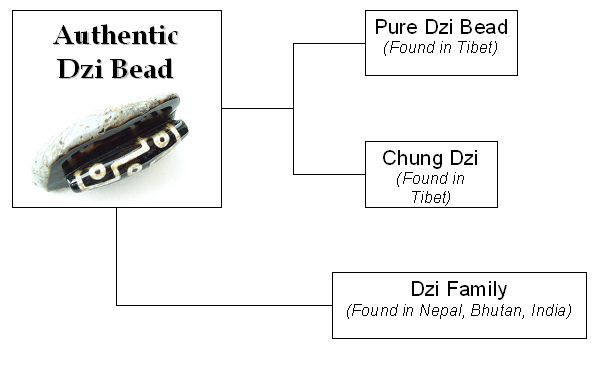
"Pure" dzi beads, in the traditional Tibetan system for evaluating dzi, are regarded as the most valuable and desirable variety. Etched agate beads not considered pure are called Chung Dzi, or "secondary, less important dzi". Lastly, etched carnelian is not recognized by the Tibetan.
A brown and milky white body color Tibetan dzi. The round brown dot surrounded by white circle is the eye of dzi. There are five eyes on this bead (called dzi mig inga pa in Tibetan language); three can be seen clearly from this photo, the other two are at the rear part of the dzi. The reader could also easily detect the weathering mark on the surface of the dzi bead. This authentic pure five-eyed dzi is a high value old bead.
The striped dzi (dkar khra men in Tibetan language) is considered the chung dzi.
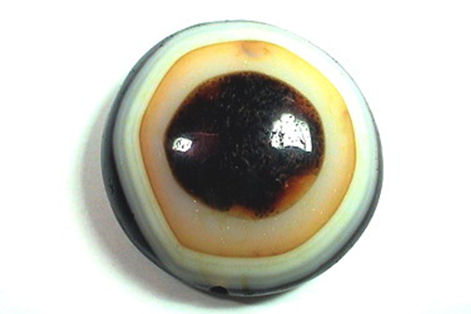
Not all pure dzi comes in the shape of tube. The above goats eye dzi (Lumik in Tibetan language) is in round shape. This bead is the traditional and effective amulet for Tibetan when they are traveling.
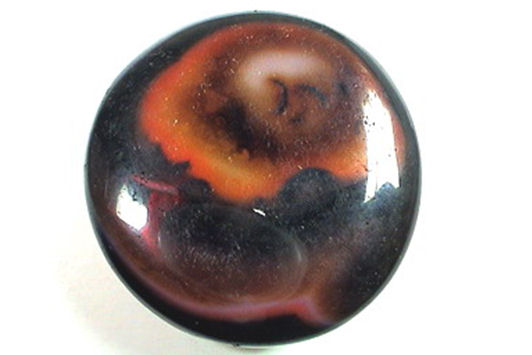
The back of the above goats eye dzi forms a beautiful pattern that looks like an aura. This dzi is a sovereign piece among the topmost group of dzi.
The Origin of Dzi Bead
The dzi bead is one of the most mysterious of all the beads known to human being today. Numerous attempts to trace back to their source yield fruitlessly although many dzi beads have been passed down from generations to generations. They exist seemingly in isolation, as if snapped from a chain, with no links to their past. It is unclear to many bead scholars the exact origin of dzi bead, why, when and how it was manufactured. The fact is these tiny stone beads patterned with mystical eyes are one of the most treasured beads in the world today. The Tibetans believe the dzi beads are the precious jewels with supernatural origin.
There are many myths and legends in Tibet describing the origin of the bead. Among the many myths and legends that follow the dzi, the main belief is that the gods created them. The Tibetan theorized divine origin rendered the dzi to be precious and powerful talismans. Most Tibetans will not let go of it because this may cause bad luck to them. In addition, the rarity of the bead makes them as valuable as diamonds in Tibet.
Most Tibetans believe that the dzi were once insects that lived in a kind of nest call dzi tshang in Tibet. When the insects were unearthed they will continue to move for a while and eventually become petrified in the form of dzi that exist today. There are stories say that the dzi were once insects but became petrified by the touch of human hand, or by the people with good karma, or by womans shirt.
Another legend said that there was a time when Tibet was overwhelmed by severe epidemic and the Tibetans were facing very hard life. Fortunately, the compassionate Vajravarahi Buddha came to rescue by releasing the magical Dzi Beads from the sky. The beads are believed to bring good luck, ward off evil, and protect the wearer from physical harm.
One of the stories describes the dzi were once wore by semi-gods in heaven as ornaments during ancient times. When the dzi gradually blemished, the semi-god throw it to the earth. Therefore, no one can ever find the beads in perfect condition.
It is also believed that the dzi beads were made from meteorites fell from outer space thousands of years ago. The magnetic field of dzi bead is three times stronger than the normal crystals.
Another legend tells the story that after Guru Rinpoche (Padmasambhava) built the first temple (Samye Monastery) in Tibet, he was blessed with dzi beads by the heavenly beings. Guru Rinpoche then buried the dzi beads all over Tibet, each with specific prayer, blessing or spiritual insight. Hundreds of year later, King Gesar of Ling Kingdom had defeated the Tagzig Kingdom, he found maps that led him to discover rare treasures, including millions of dzi beads. King Gesar brought them back as the spoils of military conquest to reward soldiers.
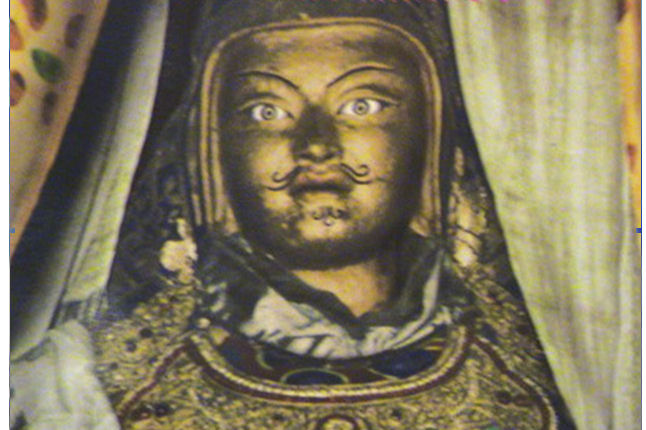
Image of Guru Rinpoche in Samye Monastery.
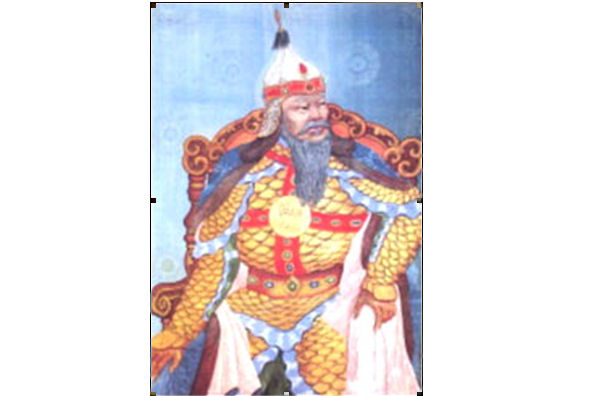
King Gesar of Tibet
The Buddhism spread to Tibet during the Tang Dynasty approximately 1,300 years ago. The Tang Emperor Taizong sent his adopted daughter, Princess Wencheng, to become the bride of the 32nd King of Tibet, Songtsen Gampo, as a strategy to harmonize the relationship between Tibet and China. Princess Wencheng brought along with her Buddhism and an image of the twelve-year-old Jobo Sakyamuni. The diadem, cape and decorative straps worn by the image of the young Buddha are studded with many pearls, agates, turquoises, corals and dzi beads. They look extremely splendid. The most precious are the three pieces of nine-eyed dzi on the diadem. Other dzi beads, around hundreds in number, display various designs including waves and tiger-tooth. At present, the image is housed and worshipped in the Jokhang Monastery.
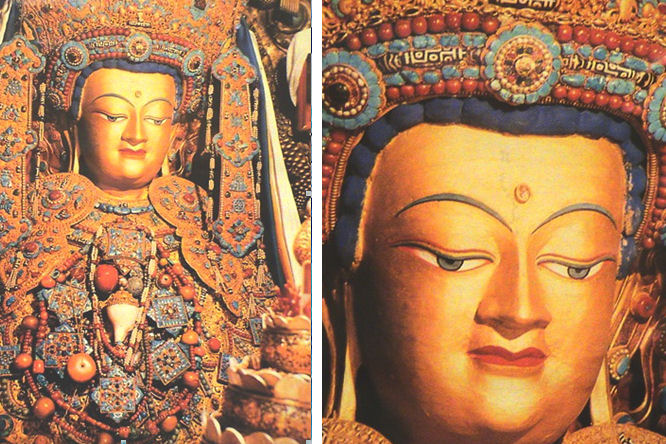
Image of Jobo Sakyamuni in Jokhang Monastery is decorated with hundreds of dzi beads, corals and turquoise.
Criteria to Identify Dzi Bead
There are many criteria to identify dzi bead such as the weathering marks, cinnabar dot, diaphaneity, circular dragon mark, body color, surface pattern, degree of perfection etc. The value of a dzi bead is determined after considering factors mentioned above. The buyers are advised to understand these criteria before making any purchases. Hopefully readers are able to appreciate the value of dzi beads with the descriptions and photos below.
1. Weathering Marks
Weathering marks are signs of aging and represent the age of a dzi bead. They are the tine lines of different thickness running irregularly on the surface of the dzi bead. However, not every old dzi bead will have the weathering marks.
2. Cinnabar Dots
Cinnabar Dots are the red or black speckles that grow from within the body of dzi to its surface. It is possible that these cinnabar dots are the effects of the magnetic interaction between the dzi and the human body after a very long time. There are two types of cinnabar dot: the red and the black cinnabar dot. The red one is more popular among the wearers. Dzi bead with black cinnabar dot is believed to have longer history or older than the red one. This is due to the observation that the red cinnabar dot will eventually turn into black after a few generations. However, dzi beads with cinnabar dots are extremely difficult to find thus the price usually very high.
3. Diaphaneity
Diaphaneity is the transparency of the dzi body, which is the ability to allow light to pass through. It was once used as the method to identify the authentication of dzi beads. It was later concluded that this could be very misleading as many authentic old dzi are not transparent. Therefore, this should not be the ONLY criteria to determine the value of Dzi.
4. Circular Dragon Marks
Circular dragon marks are the natural streaks that circulate the body of dzi. These marks are propitious signs resulted from the meditative practice of the gurus. The circular dragon marks should complete a full circle on the body of dzi and should not cut through the eye of dzi. If both conditions are not fulfilled, the value of such dzi will drop drastically.
5. Body Color
The body color of dzi could give the indication of its age. The younger bead will have body color of shining black and white; the older one varies from dark brown to light brown. Old dzi are more expensive and appreciated by collectors.
6. Motif
The motif of the dzi bead can determine the value of the dzi. The common patterns have the lower value. The unusual patterns that are difficult to find will have higher value.
7. Size of Dzi
The dzi with larger size will be at higher value.
8. Defect Quality Dzi
Sometimes you can find authentic dzi bead at very low price. This is because such dzi could be the reject quality.
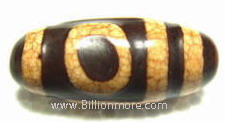 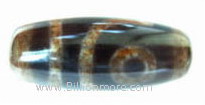 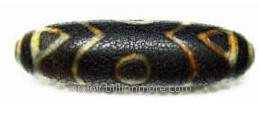
PDZBD01 PDZBD02 PDZBD03
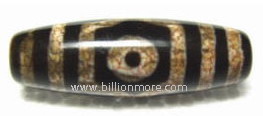 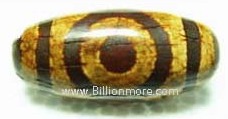 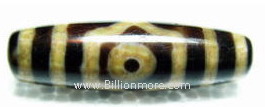
PDZBD04 PDZBD05 PDZBD06
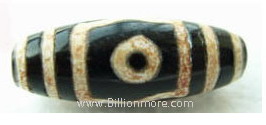 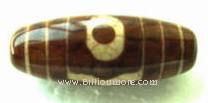 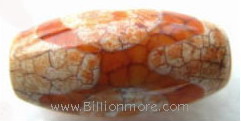
PDZBD07 PDZBD08 PDZBD09
Imitation Dzi
With the value of authentic dzi beads at the increasing trend, the market is now flooded with imitation dzi beads by using glass or poly. These have confused many buyers.
The internal color of the broken authentic pure dzi bead (right) is mainly ivory white, with the black color only covering one third of the radius. The broken imitation dzi on the left demonstrates white line just printed on the surface, the internal body looks unnatural. However, you do not have to break the dzi bead to inspect the internal structure. There are many other techniques to identify the dzi.
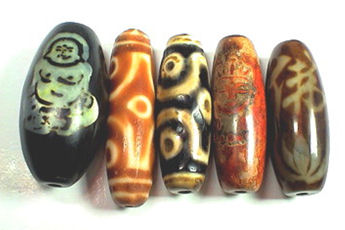
How to Make Purchasing Decision
The authentic pure dzi is not something cheap. The price is based on many factors discussed above and can be ranging from few hundred dollars to thousands, or even millions. The high value of dzi has attracted many imitations enter the market. It is so easy to find various imitation products than the real one. Here are advices you can follow to reduce the risk of getting cheated by dishonest traders.
1. Do not simply purchase dzi bead from wet market, low end trading market, kiosk in the mall, company without addresses or someone you are not familiar with. These people might claims that they are selling authentic dzi bead at attractive prices. You might not able to find them later.
2. Purchase the dzi from establish company, someone you can trust or with good knowledge in this field. It will be ideal to bring along an expert if you plan to spend a lot on dzi bead. Bring along the necessary equipments such as 10x or 30x loupe.
3. Improve your knowledge on dzi bead before making the purchase. There are many books or articles on internet that can help you understand more about dzi bead, Tibetan culture and Buddhism. Equip with such powerful knowledge will reduce the risk of making wrong decision.
4. Balance your budget for the dzi that you want to purchase. If you plan or able to spend just a little on dzi bead, starts with the cheaper one. When you feel that dzi is really good for you or your family, then upgrade to better one.
5. Do not influence by the sales person. You should have a clear state of mind. Do not be influenced by the sales person to make you purchase something out of your budget, imitation product or the dzi that not suitable for you.
If you are serious about dzi and would like to know more, here are some good books that should not be missed!
1. Bubin, Lois Sherr (1986) The History of Beads
2. Tung-Kuang, Lin (2001) Tibetan Gzi Bead
3. Hung-Shih, Chang (2003) The Bewitching Bijou of Tibet An Illustrative Study of Dzi Bead
4. K.Liu, Robert (1995) A Universal Aesthetic Collectible Beads
5. Nebesky-wajkowitz, R (1952) Prehistoric beads from Tibet
Dzi Bead in the Modern World
An elegant necklace strung with old dzi beads (One with water motif from the left most,
two three-eye and two precious bottle motif) and other crystal beads.
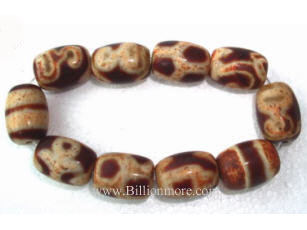
PDZBL01
The color of dzi bead works very well with corals. The necklace and bracelet are made from dzi beads that could attract wealth for the wearer; They are money hook dzi, five eyed dzi, water motif dzi, three eyed dzi, heaven and earth dzi, and lastly the qi lin motif dzi.
The combination of seven eyed dzi, treasure jar dzi, ying and yang dzi, amber, mala bead and adventurine form this simple yet beautiful necklace and bracelet.
This elegant necklace is made of dragon eyed dzi, several water motif dzi and red agate beads.
This old dragon eyed dzi is strung with red agate beads to form an elegant bracelet.
The carnelian dzi is strung with green aventurine and faceted red agate.
This two eyed dzi is strung with turquoise and onyx to form a splendid bracelet.
-------------------------------------------------------
|
Last modified : 19 Oct 2007 - 10:40 PM (GMT+7:00) |
|
|

